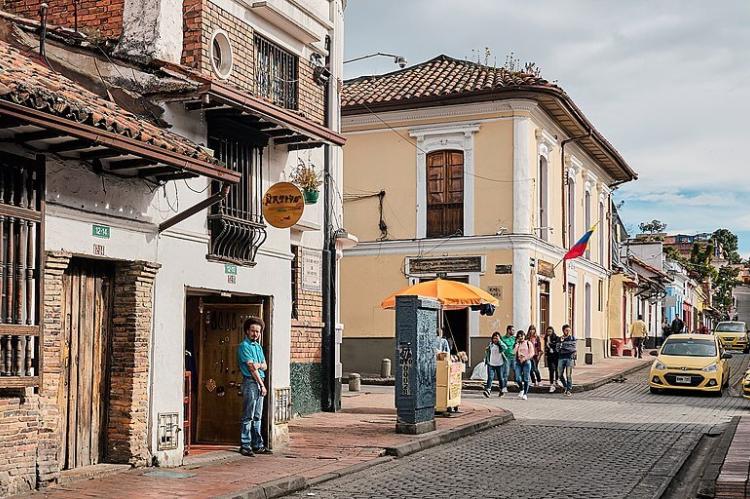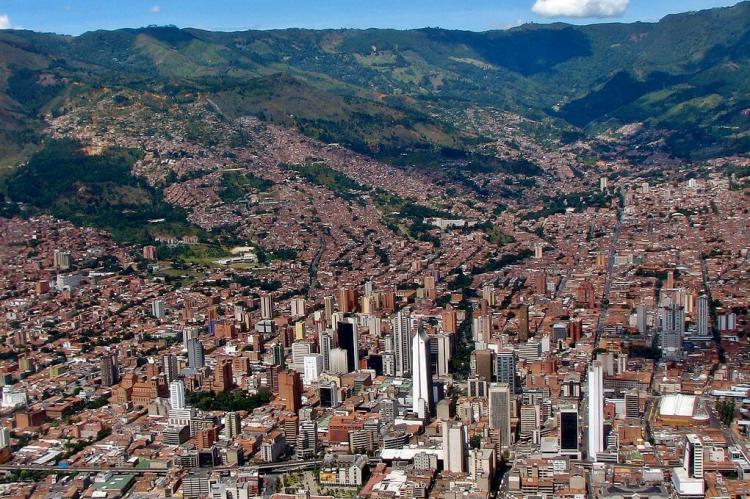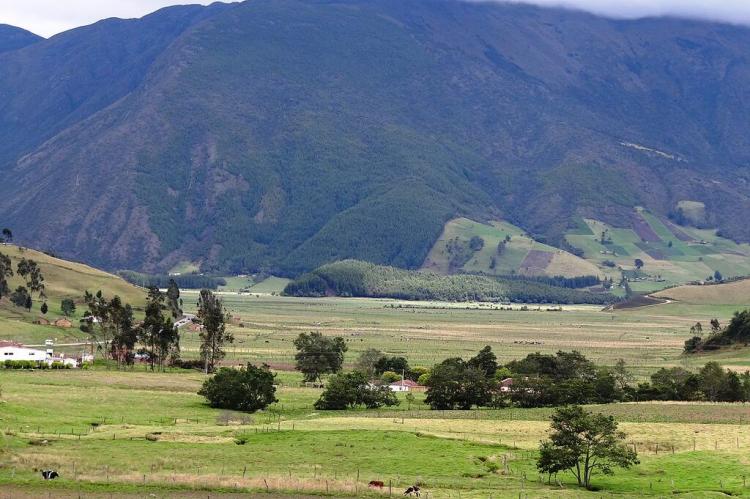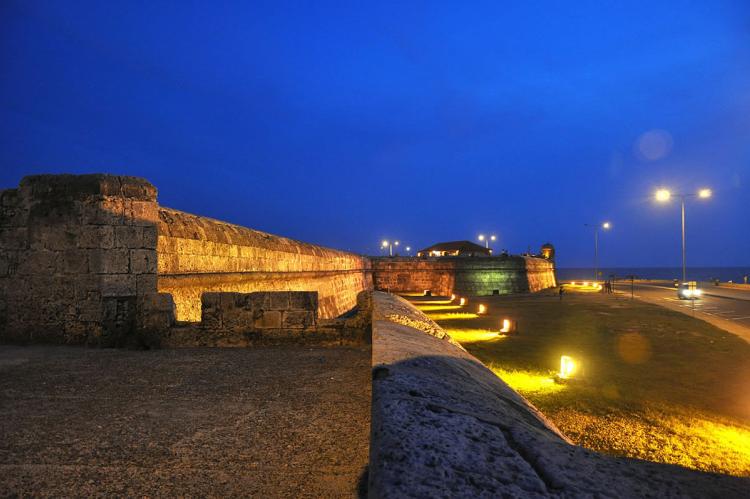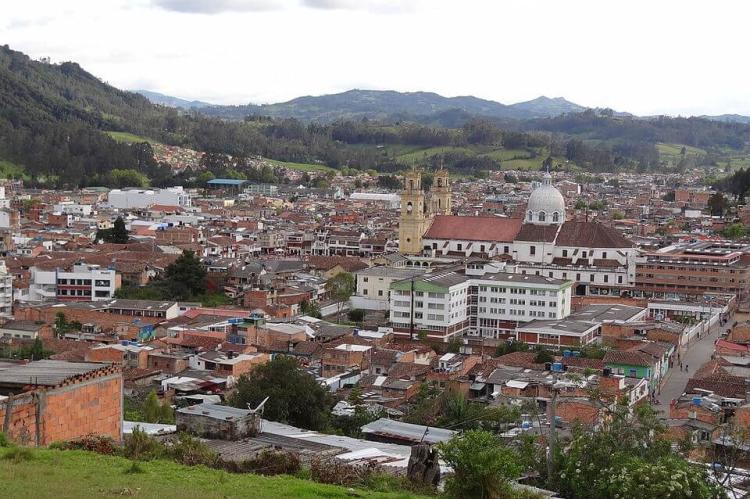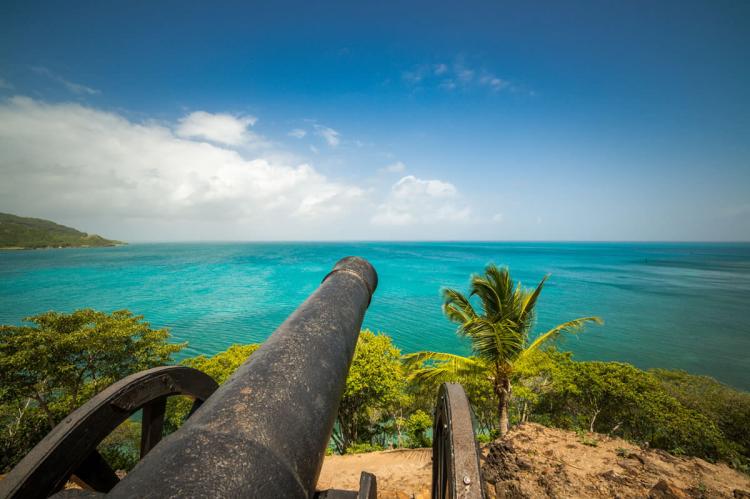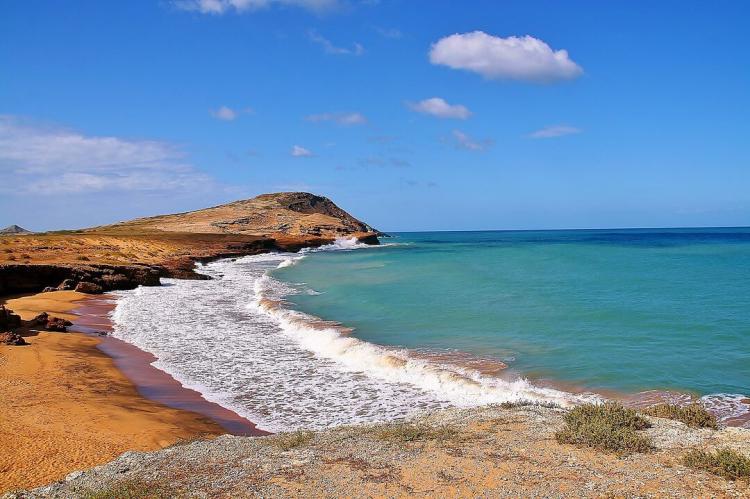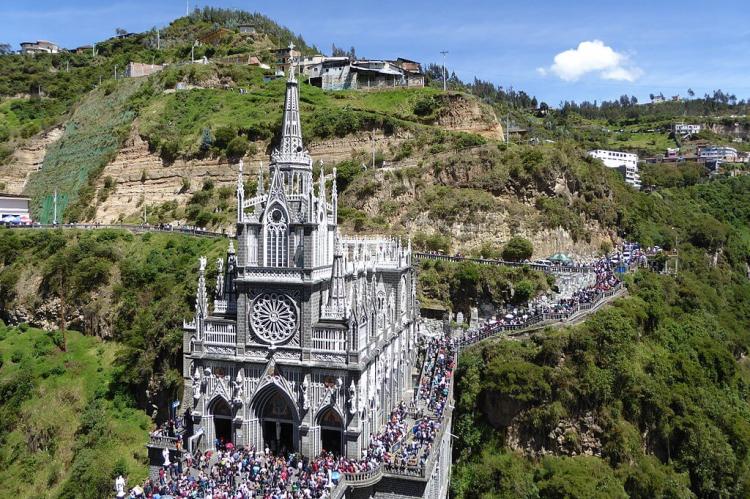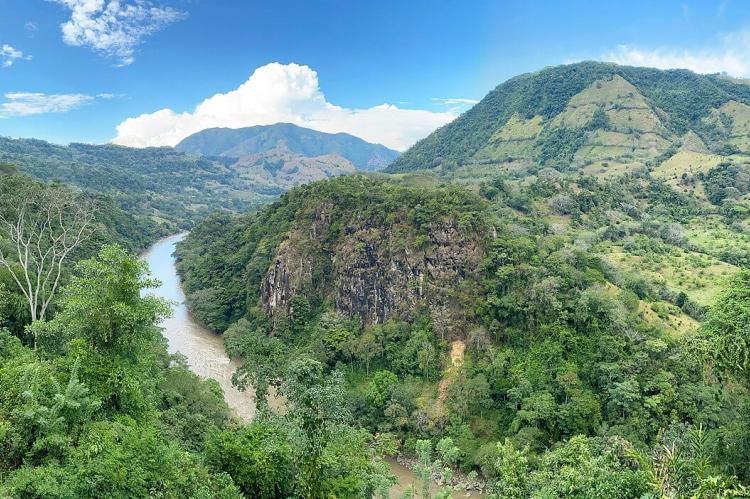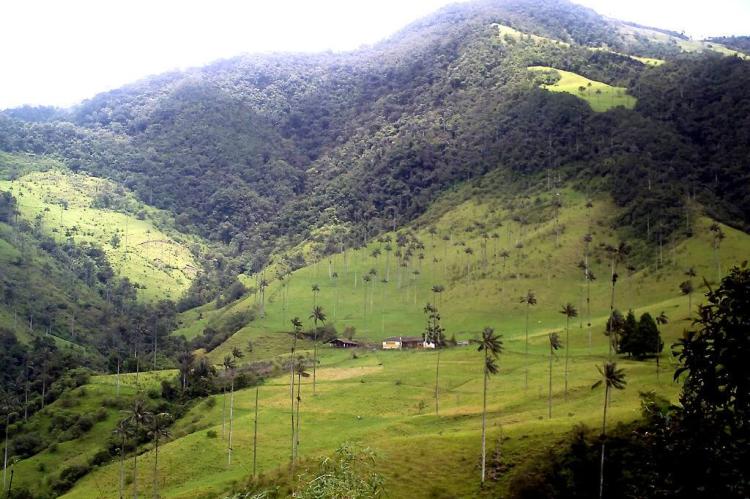Colombia: Cultural Landscape
Colombia's cultural landscape is woven together by its indigenous heritage, Spanish colonial influences, African traditions, and contemporary expressions. This South American nation stands out for its diverse cultural practices, including arts, literature, music, cuisine, and festivals.
The Cultural Landscape of Colombia
Colombia, situated at the northern tip of South America, has a rich and multifaceted cultural heritage. Its identity is deeply rooted in the blend of Indigenous traditions, Spanish colonialism, African customs, and modern global influences. Colombian culture reflects the nation's dynamic history and evolving social fabric, from its vibrant arts scene to its diverse music and cuisine. As Colombia continues to develop and interact with global trends, its cultural landscape remains a fascinating panorama of traditional practices and contemporary expressions.
Language and Religion
The official language of Colombia is Spanish, which reminds us of the country's colonial past. While most Colombians speak Spanish, the country is also home to more than 60 Indigenous languages spoken by various communities across regions. The diversity of languages reflects the cultural richness of Colombia's Indigenous groups, such as the Wayuu, Embera, and Kogi, who maintain their linguistic and cultural traditions despite external pressures.
Colombia is predominantly Christian, with Roman Catholicism as the most widely practiced religion. This religious affiliation is deeply intertwined with many aspects of Colombian society, influencing holidays, customs, and rituals. However, Protestantism has grown in influence over the past decades, and today, Evangelical Protestant churches are becoming increasingly prominent. Additionally, a small but growing number of people identify with other religions or with no faith, particularly in urban areas.
Arts and Literature
Colombian art and literature are globally recognized for their creativity and depth. Colombian literature, in particular, has made a significant mark on the world stage, with authors like Gabriel García Márquez earning international acclaim. García Márquez's masterpiece One Hundred Years of Solitude introduced the world to magical realism, blending the mystical with everyday life. His works, alongside those of other notable Colombian writers such as Álvaro Mutis and Laura Restrepo, often explore themes of social and political conflict, history, and the complex identity of Colombia.
The visual arts also thrive in Colombia. Fernando Botero, one of the country's most famous artists, is known for his distinctive style of exaggerated, voluminous figures, often used to critique society and politics. Meanwhile, Colombian artisans are renowned for their craftsmanship, producing intricate pottery, textiles, and jewelry inspired by Indigenous techniques and contemporary designs.
Music and Dance
Music is integral to Colombian life, with the country's diverse geography influencing its musical styles. In the coastal regions, Afro-Caribbean rhythms such as cumbia and vallenato dominate, blending African, Indigenous, and Spanish elements. In contrast, the Andean regions are known for bambuco and joropo, genres that reflect the rural traditions of the interior. Salsa, particularly in cities like Cali, has become a cornerstone of Colombian musical culture, with the Feria de Cali highlighting the city's passion for salsa music and dance.
The annual Barranquilla Carnival, one of Colombia's most important cultural events, showcases the country's musical diversity. The carnival features vibrant parades, music performances, and dancers in colorful costumes, demonstrating Colombia's Afro-Caribbean heritage. The champeta genre, rooted in Cartagena and influenced by African sounds, is becoming increasingly popular, especially among younger generations.
Cuisine
Colombian cuisine reflects the country's geographic diversity and agricultural wealth. Staples such as arepas (cornmeal cakes), empanadas (stuffed pastries), and bandeja paisa (a hearty platter featuring beans, rice, meat, and plantains) are common across the country. Each region has its specialties, often shaped by the local environment. For instance, coastal areas offer a wide variety of seafood dishes. At the same time, the mountainous Andean region is known for hearty soups like ajiaco, which are made with chicken, potatoes, and local herbs.
One of Colombia's most famous exports is coffee, widely regarded as some of the best in the world. The country's coffee-growing region, the Eje Cafetero, is a major tourist attraction and an important part of the national identity. Tropical fruits, such as mangoes, papayas, and guavas, are also abundant and form a key part of the Colombian diet.
Festivals and Celebrations
Festivals are at the heart of Colombian culture, providing vibrant expressions of the country's religious, historical, and cultural traditions. The Barranquilla Carnival is the most famous, bringing together music, dance, and colorful displays in a multi-day celebration. Medellín's Flower Festival (Feria de las Flores) is another significant event featuring massive floral displays and parades. During Semana Santa (Holy Week), religious processions are held across the country, particularly in the cities of Popayán and Mompox, where the events are known for their solemnity and grandeur.
Colombian festivals also celebrate the nation's cultural diversity. The Festival de la Leyenda Vallenata, held in Valledupar, honors the traditional vallenato music, while the Petronio Álvarez Festival in Cali showcases Afro-Colombian music and dance traditions from the Pacific coast. These events highlight the deep-rooted cultural practices that continue to shape the country's identity.
Sports and National Pride
Sports play an essential role in Colombian society, with football (soccer) being the most popular. Colombia's national team has achieved international success, including memorable appearances at the FIFA World Cup. Renowned players such as Carlos Valderrama, James Rodríguez, and Radamel Falcao have become national heroes, symbolizing the country's passion for the sport. Football unites Colombians from all walks of life, transcending regional and social divides.
Cycling is another sport in which Colombia has excelled. The country has produced world-class cyclists such as Nairo Quintana and Egan Bernal, who have won prestigious races like the Tour de France. The country's mountainous terrain provides a perfect training ground for endurance athletes, contributing to its success in international cycling.
Contemporary Influences on Colombian Culture
In recent years, Colombia has experienced a range of influences that continue to shape its evolving cultural landscape. Globalization, immigration, and technology have all played significant roles in shaping modern Colombian society.
Globalization
The impact of globalization is evident in many aspects of Colombian culture, particularly in its urban areas. Colombian cuisine, for example, has embraced international influences, incorporating ingredients and techniques from Europe, Asia, and North America. In the music scene, traditional genres like vallenato and cumbia are often fused with global styles such as reggaeton, electronic music, and hip hop, creating new hybrid sounds.
Immigration
Immigration has constantly influenced Colombian culture, from historical waves of African and European settlers to more recent arrivals from neighboring countries such as Venezuela and Ecuador. Immigrants have enriched Colombia's cultural diversity, bringing their traditions, languages, and cuisines. This blending of cultures is particularly noticeable in border regions and major cities.
Technology
The rise of technology and digital media has also profoundly impacted Colombian culture. Social media, in particular, has transformed how Colombians communicate and engage with the world. Musicians, artists, and writers now have new platforms to share their work, reaching global audiences and contributing to a digital cultural renaissance. In education and entertainment, the internet has expanded access to global content while allowing for the preservation and dissemination of Colombian culture through online archives and virtual exhibitions.
Challenges Facing Colombian Culture
Despite its rich cultural heritage, Colombia faces several challenges that impact its social and cultural landscape.
Social and Economic Inequality
Colombia remains one of the most unequal countries in Latin America, with deep disparities in wealth and access to education, healthcare, and essential services. While urban centers have seen significant growth and development, rural areas often lag, and Indigenous communities, in particular, face systemic inequalities. Addressing these divides is essential to fostering a more inclusive and equitable cultural landscape.
Environmental Issues
Colombia's environment is threatened by illegal mining, deforestation, and pollution, all of which pose significant challenges to preserving the country's natural and cultural resources. Indigenous groups, who often live in areas most affected by environmental degradation, face increasing threats to their land and livelihoods. Sustainable development and environmental protection are critical to preserving Colombia's cultural and ecological heritage for future generations.
Political Instability
Colombia's political landscape, governance, human rights, and security challenges remain volatile. While peace agreements with rebel groups have brought hope for stability, the country continues to grapple with issues such as corruption, violence, and drug trafficking. Political instability can disrupt cultural initiatives and limit social and cultural development opportunities.
Conclusion
Colombia's cultural landscape is a vibrant tapestry woven from its Indigenous roots, colonial history, African heritage, and modern influences. The richness of its language, arts, music, and festivals is a testament to the country's dynamic spirit and resilience. While Colombia faces significant challenges—social inequality, environmental threats, and political instability—the diversity and creativity of its people continue to shape a culture that is both deeply rooted in tradition and open to global innovation. Through its evolving cultural practices, Colombia remains a beacon of creativity and cultural expression in Latin America.
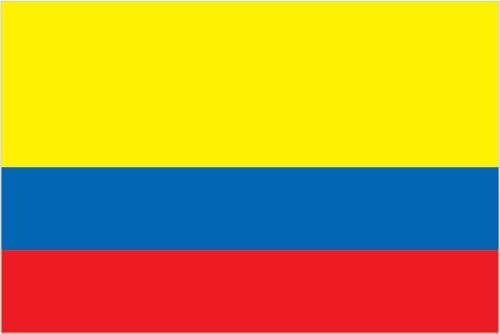
The official flag of Colombia.
Cultural Geography of Colombia
Largest Cities / Metro Areas
Ranked by population estimate (2021):
Bogotá (7,878,000): Bogotá is the capital of Colombia and is located in the center of the country, on a high plateau known as the Bogotá savanna. The city is the third-highest capital in South America, after Quito and La Paz. Bogotá is a modern city with a rich history and culture. The city is home to many museums, art galleries, and theaters, as well as several parks and green spaces. Bogotá is also a central transportation hub, with an international airport and a network of highways and railways.
Medellín (4,494,000): Medellín is located in the Antioquia department of Colombia. It is the department's capital and the second-largest city in Colombia. Situated in the Aburrá Valley in the Andes Mountains, Medellín is known as the "City of Eternal Spring" due to its mild climate. Medellín is an essential economic and cultural center in Colombia. The city is home to several universities, hospitals, and cultural institutions. Medellín is also a central transportation hub, with an international airport and a network of highways and railways. The city is also known for its vibrant nightlife and its delicious food.
Santiago de Cali (3,615,000): Cali is the third-largest city in Colombia and is located in the Valle del Cauca department. It is home to a diverse population of Colombians, Afro-Colombians, and Indigenous people. The city is known as the "Salsa Capital of the World" and is famous for its salsa music, vibrant nightlife, and delicious food. Cali is also home to several universities and colleges, making it a significant educational center in Colombia.
Barranquilla (2,315,000): Barranquilla is the capital of the Atlantic Department of Colombia. It is located on the Caribbean coast, about 130 km (80 mi) north of Bogotá. Barranquilla is a major port city and is the center of the Colombian Caribbean region. The city has several industries, including oil, gas, and manufacturing. Barranquilla is also a major tourist destination known for its Carnaval, one of the world's largest and most famous carnivals.
Cartagena de Indias (1,090,000): Cartagena is a city in Colombia located on the Caribbean coast. It is known for its beautiful colonial architecture, vibrant nightlife, and delicious food. Cartagena was founded in 1533 by the Spanish and was an important trading port for the Spanish Empire. As a result, the city was heavily fortified to protect it from pirates and other invaders. Today, Cartagena is a popular tourist destination known as the "Pearl of the Caribbean." In addition, its well-preserved historic center is a UNESCO World Heritage site.
Cúcuta (1,020,000): Cúcuta is a city in the Norte de Santander department of Colombia. It is located on the border with Venezuela, about 160 kilometers north of Bogotá. Cúcuta serves as a primary gateway between Colombia and its neighboring country. The city is a major commercial and industrial center and home to many factories that produce textiles, food, and beverages. Cúcuta is also a central transportation hub, with an international airport and a network of highways and railways.
Bucaramanga (1,009,000): Bucaramanga is the capital of the Santander department of Colombia. It is located in the eastern part of the country, on a plateau in the Colombian Andes. Bucaramanga is a center for education, commerce, and healthcare, with several universities and a thriving business sector. The city's cultural scene is active, with theaters, museums, and festivals. In addition, Bucaramanga serves as a gateway to the Chicamocha Canyon, a popular attraction known for its breathtaking views and adventure sports.
Pereira (787,000): Pereira, a major commercial and industrial center, is the capital city of the Risaralda department of Colombia. It is located in the foothills of the Andes Mountains in a coffee-producing area of Colombia, officially known as the "Coffee Axis." Pereira and the rest of the Coffee Axis form part of the UNESCO World Heritage Site known as the "Coffee Cultural Landscape of Colombia." It is the most populated city in the Coffee Axis. Pereira is part of the Central West Metropolitan Area, composed of Pereira and the neighboring towns of Dosquebradas and La Virginia.
Santa Marta (543,000): Santa Marta, situated on the Caribbean coast, is the capital of the Magdalena Department and the fourth-largest urban city of the Caribbean Region of Colombia, after Barranquilla, Cartagena, and Soledad. Founded on July 29, 1525, by the Spanish conqueror Rodrigo de Bastidas, it was one of the first Spanish settlements in Colombia, its oldest surviving city, and the second oldest in South America. Santa Marta is a popular tourist destination known for its beautiful beaches, colonial architecture, and proximity to the Tayrona National Park.
Ibagué (531,000): Ibagué is the capital of the Tolima department in Colombia. It is located near Nevado del Tolima in the country's center, on the central mountain range of the Colombian Andes. Ibagué is known as the "Musical Capital of Colombia" due to its vibrant music scene. The city also has several universities, hospitals, and cultural institutions. Ibagué is also a central transportation hub, with an international airport and a network of highways and railways.
Administrative Divisions
Colombia has 32 departments and a Capital District home to the country's capital, Bogotá. Bogotá has a mayor and council but is not part of any department. A grouping of municipalities forms departments, although some departments have subdivisions called provinces that are above the level of municipalities. Each department has a capital, a Governor, and an Assembly.
Indigenous territories and municipalities are at Colombia's third administrative division level. They are found mainly in the departments of Amazonas, Cauca, La Guajira, Guaviare, and Vaupés.
Departments
An alphabetical list of Colombia's departments, including their capitals in parentheses and brief descriptions, is provided below:
Amazonas (Leticia): Located in the southernmost part of Colombia, bordering Brazil and Peru, Amazonas is known for its lush rainforests and the Amazon River. It is a region of incredible biodiversity and Indigenous communities.
Antioquia (Medellín): Located in northwest Colombia, Antioquia is known for its stunning landscapes, including the Andes Mountains. Medellín, the capital, is a central cultural and economic hub, and the department is famous for its coffee production.
Arauca (Arauca): Arauca is in eastern Colombia, sharing a border with Venezuela. It's known for its oil industry and rural landscapes.
Atlántico (Barranquilla): Atlántico is located in northern Colombia on the Caribbean coast and is known for its vibrant culture, beautiful beaches, and the annual Barranquilla Carnival, one of the largest in the country.
Bolivar (Cartagena): Bolívar, located on the Caribbean coast of northern Colombia, is home to the historic city of Cartagena, known for its well-preserved colonial architecture, beaches, and cultural heritage.
Boyacá (Tunja): Boyacá is situated in central Colombia, within the Andean region. It is known for its colonial towns, rolling hills, and important historical events during Colombia's fight for independence.
Caldas (Manizales): Located in central Colombia, Caldas is known for its mountainous terrain and coffee production. Manizales, the capital, is a significant coffee processing and trading hub.
Caquetá (Florencia): Caquetá is located in southern Colombia, within the Amazon rainforest region and is known for its biodiversity and lush landscapes.
Casanare (Yopal): Casanare is located in the Llanos region in eastern Colombia. It is characterized by vast plains and cattle ranching and is known for its cowboy culture.
Cauca (Popayán): In southwest Colombia, Cauca is known for its Indigenous cultures, beautiful landscapes, and the historic city of Popayán, famous for its colonial architecture.
Cesar (Valledupar): Located in northern Colombia on the Caribbean coast, Cesar is known for its music and culture. Valledupar is considered the birthplace of vallenato, a popular folk music genre.
Chocó (Quibdó): Chocó is located on the Pacific coast of western Colombia and is known for its rainforests, Afro-Colombian culture, and biodiversity.
Córdoba (Montería): Córdoba, in northern Colombia, is known for its agriculture, including cotton and rice production, and its coastal areas along the Caribbean Sea.
Cundinamarca (Bogotá): Cundinamarca surrounds the capital city of Bogotá in central Colombia and is known for its diverse landscapes, including the Andes Mountains and fertile valleys.
Guainía (Inirida): Guainía, in eastern Colombia, is located in the Amazon rainforest and is known for its Indigenous communities and natural beauty.
Guaviare (San José del Guaviare): Guaviare is another Amazonian department in southern Colombia known for its ecotourism and jungle landscapes in southern Colombia.
Huila (Neiva): Located in the Andes mountains of southwestern Colombia, Huila is known for its coffee production, rolling hills, and the Tatacoa Desert, a popular tourist destination.
La Guajira (Riohacha): La Guajira is located on the Caribbean coast of northern Colombia and is known for its arid landscapes, Indigenous Wayuu culture, and stunning beaches.
Magdalena (Santa Marta): Located in northern Colombia, Magdalena is known for its coastal areas, including the historic city of Santa Marta and the Sierra Nevada de Santa Marta mountains.
Meta (Villavicencio): Located in eastern Colombia, Meta is part of the Orinoco River basin. It is known for its cattle ranching, llanero culture, and natural parks.
Nariño (Pasto): Nariño is located in the Andes of southwestern Colombia and is known for its diverse landscapes, including mountains, lakes, and volcanoes.
Norte de Santander (Cúcuta): In eastern Colombia, Norte de Santander shares a border with Venezuela and is known for its historical sites, including the town of Cúcuta and its beautiful landscapes.
Putumayo (Mocoa): Putumayo is located in the Amazon basin of southern Colombia and is known for its biodiversity and Indigenous cultures.
Quindio (Armenia): In the Andes of central Colombia, Quindío is part of the coffee-growing region known as the Coffee Triangle. It is famous for its coffee farms and natural beauty.
Risaralda (Pereira): Risaralda, also part of the Coffee Triangle in central Colombia, is known for its coffee production, hot springs, and vibrant cities.
San Andrés y Providencia (San Andrés): This department includes the Caribbean islands of San Andrés, Providencia, and Santa Catalina, known for their stunning beaches and cultural diversity.
Santander (Bucaramanga): Located in the Andes of central Colombia, Santander is known for its adventurous activities, such as paragliding and rafting, and charming colonial towns, such as Barichara.
Sucre (Sincelejo): In northern Colombia, Sucre is known for its coastal areas, including the Gulf of Morrosquillo, and its vibrant cultural heritage.
Tolima (Ibagué): In the Andes of central Colombia, Tolima is known for its natural beauty, including lakes, rivers, and mountains. It's also famous for its musical traditions.
Valle del Cauca (Cali): In western Colombia, Valle del Cauca is known for its salsa music and dance culture, as well as its Pacific coastline and urban centers like Cali.
Vaupés (Mitú): Vaupés is located in the Amazon region of eastern Colombia and is known for its remote and pristine wilderness.
Vichada (Puerto Carreño): Vichada is in eastern Colombia and is known for its wildlife and the Orinoco River.
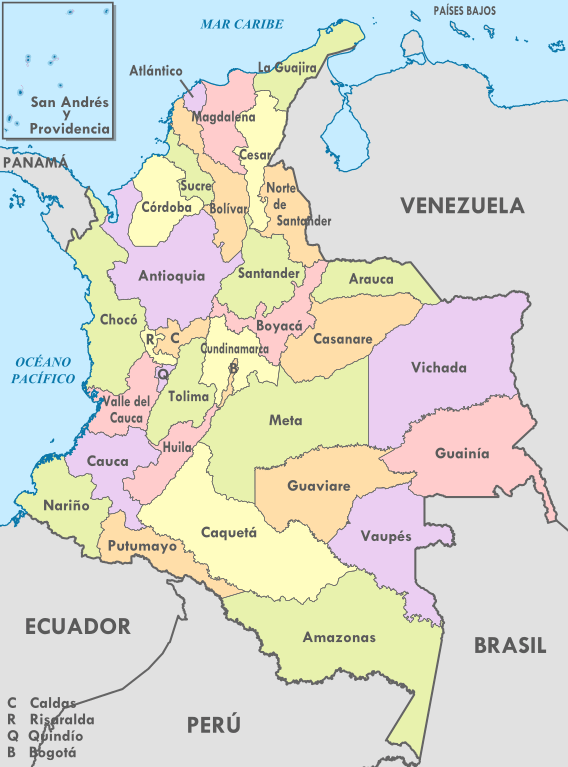
Map depicting the departments of Colombia.
Natural Regions (Zones)
Colombia generally classifies its geographic landscape into six natural regions:
Caribbean Region (north)
The Caribbean region of Colombia is located in the north of the country. It borders the Caribbean Sea to the north, Panama to the west, Venezuela to the east, and the Colombian Andean region to the south. It has a population of over 9 million people and is made up of 8 departments: Atlántico, Bolívar, Cesar, Córdoba, Magdalena, La Guajira, Sucre, and San Andrés and Providencia.
Pacific/Chocó Region (west)
The Pacific/Chocó region is located in the northwestern part of Colombia. It borders the Pacific Ocean to the west, Panama to the northwest, the Colombian Andes to the east, and the Nariño and Cauca departments to the south. It has a population of over 700,000 and comprises the Chocó department and the northern part of the Valle del Cauca department.
Andean Region (center)
The Andean region of Colombia is located in the central and western parts of the country. The Pacific Ocean borders it to the west, the Caribbean Sea to the north, the Amazon Rainforest to the east, and the Venezuelan Andes to the south. It has a population of over 40 million people. It is made up of 13 departments: Antioquia, Boyacá, Caldas, Cundinamarca, Huila, Nariño, Norte de Santander, Quindío, Risaralda, Santander, Tolima, and Valle del Cauca.
Orinoco Region (east)
The Orinoco Region is located in the eastern part of Colombia and belongs to the Orinoco River watershed. Venezuela borders it to the east, Brazil to the south, and the Amazon Rainforest to the southwest. It has over 2 million people and comprises the following departments: Arauca, Casanare, Meta, and Vichada.
Amazon Region (south)
The Amazon Region of Colombia is located in the country's southeast and is bordered by Brazil to the south and east, Peru to the southeast, and Venezuela to the north. It has over 800,000 people and comprises the following departments: Amazonas, Caquetá, Guainía, Guaviare, Putumayo, and Vaupés.
Insular Region (Caribbean and Pacific)
The Insular Region of Colombia is located in the Caribbean Sea and the Pacific Ocean. It includes the San Andrés, Providencia, and Santa Catalina islands in the Caribbean Sea and Gorgona Island and Malpelo Island in the Pacific Ocean.
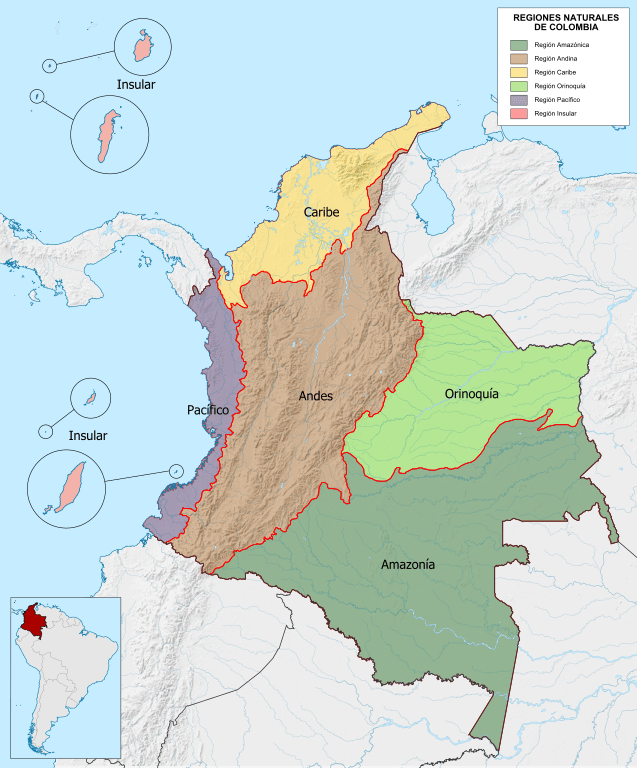
Map depicting the natural regions of Colombia.
Historical, Cultural, and Natural Landmarks
Colombia is a diverse and vibrant country with a rich blend of historical, cultural, and natural landmarks. Here are some notable landmarks in each category, separated by region:
Caribbean Region
The Caribbean Region of Colombia, also known as the North Caribbean or Costa Norte, encompasses a coastal strip along the Caribbean Sea. This region is characterized by its stunning beaches, vibrant culture, and historical significance. Here's a description of the Caribbean Region of Colombia and its main attractions:
Cartagena: Cartagena is the crown jewel of the Caribbean coast and one of Colombia's most iconic cities. The walled city's well-preserved historic center is a UNESCO World Heritage site. With its colorful colonial architecture, narrow streets, and charming plazas, Cartagena exudes a romantic and enchanting atmosphere. Visitors can explore the Castillo San Felipe de Barajas fortress, enjoy the vibrant nightlife in the Getsemaní neighborhood, and relax on the beautiful beaches of Bocagrande and Playa Blanca.
Santa Marta: Located on the eastern coast, Santa Marta is a lively city and gateway to several stunning natural attractions. It is the starting point for exploring the Sierra Nevada de Santa Marta, the world's highest coastal mountain range. Visitors can embark on treks to the Lost City (Ciudad Perdida), hike to the beautiful beaches of Parque Nacional Natural Tayrona, or venture into the biodiverse landscapes of Parque Nacional Natural Sierra Nevada.
La Guajira Peninsula: The northernmost point of South America is in the La Guajira Peninsula. This unique desert-like region is home to the Indigenous Wayuu people and offers breathtaking landscapes. Visitors can experience the contrasting beauty of the vast desert dunes, pristine beaches, and the stunning Cabo de la Vela, a picturesque coastal village with crystal-clear waters and rugged cliffs.
Palomino: Nestled between the Sierra Nevada de Santa Marta and the Caribbean Sea, Palomino is a tranquil coastal town renowned for its natural beauty. It is an ideal destination for outdoor enthusiasts, offering opportunities for tubing down the Palomino River, hiking through lush forests, and enjoying long stretches of pristine beaches.
Barranquilla: Known for its vibrant Carnaval de Barranquilla, one of Colombia's most celebrated festivals, Barranquilla is a bustling city with a rich cultural heritage. It boasts a lively music and dance scene, with genres like cumbia and vallenato deeply rooted in the local culture. The city also has a vibrant culinary scene where visitors can savor delicious coastal dishes.
Pacific/Chocó Region
The Pacific/Chocó Region of Colombia, located on the western coast, is a lush and biodiverse area known for its rainforests, pristine beaches, and vibrant Afro-Colombian culture. This region is characterized by its stunning natural landscapes and unique cultural heritage. Here's a description of the Pacific/Chocó Region and its main attractions:
Nuquí and Bahía Solano: Nuquí and Bahía Solano are two coastal towns known for their beautiful beaches and rich biodiversity. These remote destinations offer ecotourism opportunities, with activities such as whale watching (between July and November), snorkeling, and exploring the surrounding rainforests. Visitors can also experience Afro-Colombian culture and traditions, including music, dance, and cuisine.
Utría National Natural Park: Utría National Natural Park is a pristine protected area encompassing both land and sea. It features dense rainforests, mangroves, waterfalls, and an extensive marine ecosystem. The park is home to various wildlife, including humpback whales, sea turtles, monkeys, and bird species. Visitors can hike through the rainforest, explore coastal mangroves, and witness the region's incredible biodiversity.
San Cipriano: San Cipriano is a unique Afro-Colombian village in the jungle. Its ingenious mode of transportation makes it unique—bamboo rafts, known as "brujitas," run along railroad tracks. Visitors can enjoy a thrilling ride through the jungle, relax in natural river pools, and immerse themselves in the local culture.
Bahía Málaga: Bahía Málaga is a picturesque bay located near Buenaventura. It features tranquil beaches, mangroves, and coral reefs, making it an ideal destination for snorkeling and diving. The area is known for its stunning marine biodiversity, colorful coral formations, and abundant marine life.
Buenaventura: Buenaventura is the largest port city on Colombia's Pacific coast. While it is an important commercial hub, it also offers beautiful beaches and a vibrant Afro-Colombian culture. Visitors can enjoy local cuisine, music, and dance, explore nearby islands and participate in water activities like fishing and kayaking.
Andean Region
The Andean Region of Colombia in the south is a mountainous area characterized by stunning landscapes, rich cultural heritage, and historical significance. This region is part of the Andes mountain range and offers diverse attractions. Here's a description of the Andean Region (south) of Colombia and its main attractions:
Popayán: Known as the "White City," Popayán is a colonial gem with well-preserved architecture and a rich cultural heritage. Its historic center features beautiful churches, plazas, and cobblestone streets. Popayán is famous for its Semana Santa (Holy Week) celebrations, where processions and religious events occur.
Barichara: Tucked into the Andean hills of northern Colombia, Barichara appears frozen in time. With its cobbled streets, whitewashed colonial houses, and terracotta rooftops, it is widely celebrated as one of Colombia's most beautiful villages.
San Agustín Archaeological Park: San Agustín Archaeological Park is a UNESCO World Heritage site and one of Colombia's most important archaeological sites. It is renowned for its collection of ancient stone sculptures and tombs dating back to the pre-Columbian era. Visitors can explore the park's archaeological sites, statues, and lush natural surroundings.
Tierradentro Archaeological Park: This UNESCO World Heritage site is home to a complex of underground tombs and burial chambers created by the region's Indigenous cultures. The park offers guided tours that allow visitors to explore these fascinating ancient structures and learn about the Indigenous cultures that inhabited the area.
Puracé National Natural Park: Puracé National Natural Park is located in the Central Cordillera of the Andes and is known for its stunning volcanic landscapes. The park features the Puracé Volcano, one of Colombia's most active volcanoes. Visitors can hike through the park's diverse ecosystems, including páramos (high-altitude moorlands), forests, and hot springs.
Tatacoa Desert: Although technically located in the Huila Department, the Tatacoa Desert is often considered part of the Andean Region. Its unique and otherworldly landscape is characterized by its arid canyons, eroded rock formations, and star-filled night skies. Visitors can explore the desert on foot or by bike, and stargazing tours are popular due to the area's low light pollution.
Nevado del Huila: Nevado del Huila is an active stratovolcano with the highest peak in the Colombian Andes. It is part of the Los Nevados National Natural Park and offers breathtaking views of snow-capped peaks, glaciers, and paramos. Hiking and mountaineering enthusiasts can embark on challenging expeditions to explore the majestic mountain.
Pasto: Pasto is the capital of the Nariño Department and serves as a gateway to explore the southern Andean Region. The city is known for its colonial architecture, vibrant culture, and the famous Carnaval de Negros y Blancos, a UNESCO Intangible Cultural Heritage festival. Nearby attractions include the beautiful Laguna de la Cocha and the thermal baths of San Juan de Pasto.
Amazon Region
The Amazon Region of Colombia is a vast and biodiverse area characterized by dense rainforests, winding rivers, and unique flora and fauna. It is part of the larger Amazon Rainforest, one of the planet's most ecologically diverse regions. Here are some of the main attractions in the Amazon Region of Colombia:
Leticia: Leticia is the capital city of the Amazonas Department and serves as the main gateway to the Colombian Amazon. It is located on the banks of the Amazon River and offers a blend of cultural diversity and natural beauty. Visitors can explore the bustling market, visit Indigenous communities, and enjoy boat rides along the Amazon River.
Amacayacu National Natural Park: Amacayacu National Natural Park is a protected area near Leticia. It encompasses a vast pristine rainforest and is home to diverse wildlife, including monkeys, birds, pink dolphins, and caimans. Visitors can take guided hikes and boat tours and even stay in eco-lodges to immerse themselves in the park's natural beauty.
Puerto Nariño: Puerto Nariño is a small, picturesque village along the Amazon River. It is known for its sustainable and eco-friendly practices, with restrictions on using motorized vehicles and a focus on community-based tourism. Visitors can explore the village's colorful houses, enjoy nature walks in the surrounding forests, and interact with Indigenous communities.
Tanimboca Nature Reserve: Tanimboca Nature Reserve is a private reserve near Leticia that offers immersive experiences in the Amazon rainforest. Visitors can take canopy tours, hike through the jungle, and stay in treehouse accommodations to observe the region's rich biodiversity up close.
Indigenous Communities: The Colombian Amazon is home to various Indigenous communities, including the Tikuna, Yagua, Huitoto, and Ocaina. These communities have preserved their traditions, culture, and deep connection to the rainforest. Visitors can learn about their way of life, participate in traditional ceremonies, and purchase handmade crafts.
Yahuarcaca Lakes: The Yahuarcaca Lakes are a series of lakes near Leticia renowned for their stunning natural beauty. Visitors can take boat trips or kayak through the lakes, surrounded by lush vegetation and the sounds of wildlife.
Insular Region
The Insular Region of Colombia consists of several islands and archipelagos located in the Caribbean Sea and the Pacific Ocean. These islands offer breathtaking natural beauty, vibrant marine ecosystems, and a unique cultural heritage. Here's a description of the Insular Region of Colombia and its main attractions:
San Andrés: San Andrés is the largest island in the Colombian Caribbean and one of the region's most popular tourist destinations. It is renowned for its stunning white-sand beaches, crystal-clear turquoise waters, and the seven-color sea. Visitors can enjoy various water activities such as snorkeling, diving, and kayaking to explore the vibrant coral reefs. The island also offers duty-free shopping, delicious seafood, and lively nightlife.
Providencia and Santa Catalina: Providencia and Santa Catalina are sister islands near San Andrés. These tranquil and unspoiled destinations offer pristine beaches, lush landscapes, and a relaxed atmosphere. Providencia is known for its stunning landscapes, like the famous "Peak" or El Pico, which offers panoramic views of the island. The area is also a marine protected area, providing excellent diving and snorkeling opportunities.
Rosario Islands: The Rosario Islands are a group of beautiful islands located off the coast of Cartagena in the Colombian Caribbean. These islands offer stunning beaches, coral reefs, and a vibrant marine ecosystem. Visitors can take boat tours to explore the islands, relax on secluded beaches, and enjoy snorkeling or diving in crystal-clear waters.
Gorgona Island: Gorgona Island is located in the Pacific Ocean and is known for its rich biodiversity and pristine natural environment. It is a national natural park and a UNESCO World Heritage site. The island offers opportunities for wildlife spotting, including humpback whales (between July and November), dolphins, sea turtles, and various bird species. In addition, visitors can explore the island's rainforest, go hiking, and learn about its history as a former prison.
Malpelo Island: Malpelo Island is a remote and uninhabited island in the Pacific Ocean. Due to its abundant marine life and underwater cliffs, it is renowned as one of the best diving destinations in the world. The island is a UNESCO World Heritage site and a marine protected area, home to sharks, rays, sea turtles, and various fish species.
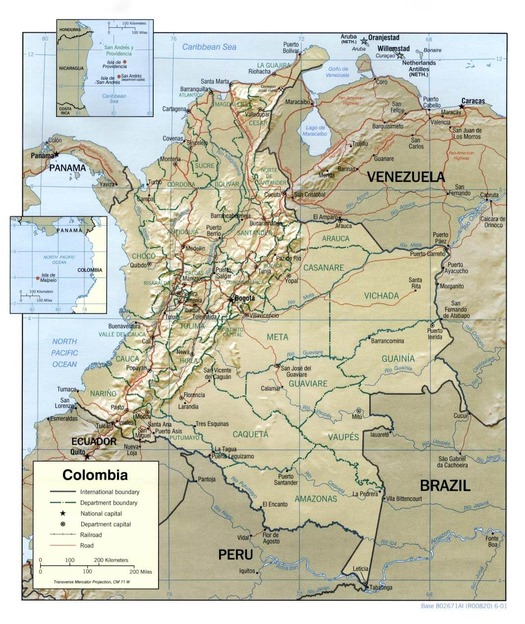
Colombia physiographic map.
